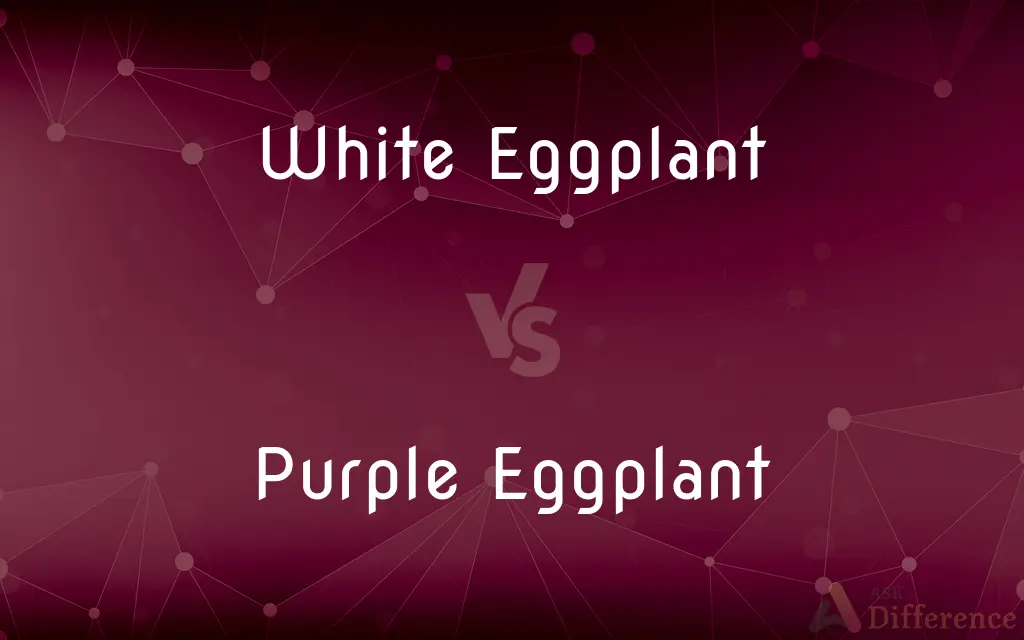White Eggplant vs. Purple Eggplant — What's the Difference?
By Tayyaba Rehman & Fiza Rafique — Published on February 9, 2024
White Eggplant differs from Purple Eggplant mainly in color and slightly in taste; White Eggplant is creamy-white and milder, while Purple Eggplant is deep purple and slightly richer in flavor.

Difference Between White Eggplant and Purple Eggplant
Table of Contents
ADVERTISEMENT
Key Differences
White Eggplant and Purple Eggplant are both varieties of the same plant, Solanum melongena. The White Eggplant, as its name suggests, bears creamy-white fruit, which tends to be smaller and rounder compared to the Purple Eggplant. The Purple Eggplant, the more commonly known variety, typically has a deep purple, glossy skin and is larger and more elongated.
In terms of taste and texture, the White Eggplant is known for its slightly sweeter and milder flavor compared to the Purple Eggplant. The flesh of the White Eggplant is also denser and less spongy. On the other hand, the Purple Eggplant has a slightly richer taste and a more traditional eggplant texture, which can be a bit more spongy and absorbent, making it ideal for dishes like eggplant Parmesan.
Cooking methods for White Eggplant and Purple Eggplant can vary due to their textural differences. White Eggplant, with its denser flesh, is excellent for grilling or sautéing, as it holds its shape well. Purple Eggplant, being more absorbent, is great for recipes that involve baking or frying, as it soaks up flavors effectively.
Nutritional content in both White Eggplant and Purple Eggplant is similar, but the purple skin of the Purple Eggplant contains anthocyanins, potent antioxidants. Both are low in calories and rich in fiber, but the Purple Eggplant has this added nutritional benefit due to its pigmentation.
Culturally, the Purple Eggplant is more widespread and recognized in global cuisine, often seen in Mediterranean, Middle Eastern, and Asian dishes. The White Eggplant, while less common, is gaining popularity for its unique appearance and is used in similar culinary applications as the Purple Eggplant.
ADVERTISEMENT
Comparison Chart
Color
Creamy-white skin
Deep purple skin
Size and Shape
Smaller, rounder
Larger, elongated
Taste
Milder, slightly sweeter
Slightly richer
Texture
Denser, less spongy
More spongy, absorbent
Culinary Use
Better for grilling and sautéing
Ideal for baking and frying
Compare with Definitions
White Eggplant
White Eggplant is smaller and denser than its purple counterpart.
White Eggplant is perfect for my stir-fry due to its firm texture.
Purple Eggplant
Purple Eggplant's spongy texture makes it ideal for absorbing flavors.
The Purple Eggplant perfectly soaked up the marinade in the stir-fry.
White Eggplant
A variety of eggplant with a creamy-white exterior and mild taste.
I grilled White Eggplant for a light, flavorful addition to our salad.
Purple Eggplant
This eggplant is a staple in many cuisines for its versatile flavor and texture.
I used Purple Eggplant to make a delicious, traditional moussaka.
White Eggplant
White Eggplant can be distinguished by its ivory skin and rounded shape.
The White Eggplant stood out in the dish with its striking appearance.
Purple Eggplant
A common variety of eggplant with a deep purple skin and rich flavor.
The Purple Eggplant added a vibrant color and depth to the ratatouille.
White Eggplant
This eggplant variant is celebrated for its sweet, mild flavor.
I prefer White Eggplant in my dishes for a subtler taste.
Purple Eggplant
Purple Eggplant is known for its elongated shape and glossy skin.
She sliced the Purple Eggplant for her famous baked casserole.
White Eggplant
Known for its unique color, White Eggplant is a less common variety of eggplant.
The White Eggplant in the market was a delightful find for my vegetable collection.
Purple Eggplant
With its anthocyanin-rich skin, Purple Eggplant offers added antioxidants.
Choosing Purple Eggplant not only enhances the dish but also adds nutritional value.
Common Curiosities
What is the main visual difference between White Eggplant and Purple Eggplant?
White Eggplant has a creamy-white skin, while Purple Eggplant is known for its deep purple color.
Can White Eggplant and Purple Eggplant be used interchangeably in recipes?
Yes, they can be used interchangeably, but their slight taste and texture differences might alter the dish's final flavor and texture.
Are there any cooking methods that are particularly good for White Eggplant?
Grilling and sautéing are great methods for White Eggplant, as it holds its shape well.
Which eggplant variety is better for frying, White or Purple Eggplant?
Purple Eggplant is more suitable for frying due to its spongier texture.
Is White Eggplant less common than Purple Eggplant in grocery stores?
Yes, White Eggplant is generally less common than Purple Eggplant.
Is the skin of both White and Purple Eggplant edible?
Yes, the skin of both White and Purple Eggplant is edible.
How should White Eggplant be stored compared to Purple Eggplant?
Both should be stored in a cool, dry place and used relatively quickly after purchase.
Is the nutritional value of White Eggplant different from Purple Eggplant?
Both have similar nutritional profiles, but Purple Eggplant's skin contains additional antioxidants.
Does the taste of White Eggplant differ significantly from Purple Eggplant?
White Eggplant is milder and slightly sweeter compared to the slightly richer taste of Purple Eggplant.
Can White Eggplant and Purple Eggplant be grown in home gardens?
Yes, both can be grown in home gardens if the climate and soil conditions are suitable.
Can both White Eggplant and Purple Eggplant be eaten raw?
Yes, both can be eaten raw, but they are more commonly cooked.
Are there any specific dishes where White Eggplant is preferred?
White Eggplant is often preferred in dishes where a milder, sweeter flavor is desired.
Is Purple Eggplant more widely used in global cuisines compared to White Eggplant?
Yes, Purple Eggplant is more commonly used in a variety of global cuisines.
Are there any allergy concerns with either White or Purple Eggplant?
Allergies to eggplant are rare but possible with both varieties.
Do White Eggplant and Purple Eggplant have the same growing conditions?
Yes, they generally have similar growing conditions.
Share Your Discovery

Previous Comparison
Qualified Stock Options vs. Non-Qualified Stock Options
Next Comparison
Calloc vs. MallocAuthor Spotlight
Written by
Tayyaba RehmanTayyaba Rehman is a distinguished writer, currently serving as a primary contributor to askdifference.com. As a researcher in semantics and etymology, Tayyaba's passion for the complexity of languages and their distinctions has found a perfect home on the platform. Tayyaba delves into the intricacies of language, distinguishing between commonly confused words and phrases, thereby providing clarity for readers worldwide.
Co-written by
Fiza RafiqueFiza Rafique is a skilled content writer at AskDifference.com, where she meticulously refines and enhances written pieces. Drawing from her vast editorial expertise, Fiza ensures clarity, accuracy, and precision in every article. Passionate about language, she continually seeks to elevate the quality of content for readers worldwide.
















































